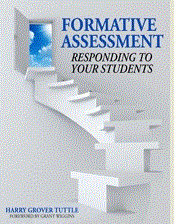I teach a college composition course. We spend much time in peer reviewing (probably 70% of class time) in a formative assessment process. Today the students had their 6th peer review on the same “essay” and we are just up to doing three body paragraphs. I asked my students to do a questionnaire on the process we use. About 15% said that they did not peer review in their high school English classes. Of those they did peer review, they stated that peer review focused on grammar, spelling and punctuation. As one student said of our process, “we focus on changing idea.” Most students (80%) had not had more than one peer review their writing; so far we have had 6 different peers react to their writing. As one student mentioned “you get a different view and different aspects about your paper from other people ” and “You receive others’ opinions using the same format you used to write it.” My goal is simple: for students to constantly improve in their writing. Formative assessment which focuses on monitoring and giving feedback continually through the process enables students to improve in each aspect of their writing, starting at the pre-writing phase. A more thorough description of this process is found in my Successful Student Writing Through Formative Assessment
How often do your students peer review each other’s work?
My book, Formative Assessment: Responding to Your Students, is available through Eye on Education.
Also, my book, Successful Student Writing Through Formative Assessment, is available through Eye on Education.



How valuable is Peer Review?
Published December 15, 2008 Change , Comment , Composition , Edublogger , Education , ELA , English , Feedback , peer , Peer Review , Review , Revision , write , Writing Leave a CommentTags: Change, Comments, Composition, edublooger, Education, English, Essay, Feedback, Improve, peer, Peer Review, Revision, write, Writing
When my students hand in their final English essay, they also hand in their peer reviewed draft. I’ve noticed that usually they do not incorporate the changes that peers suggest.
I gave them a survey on peer review to help me better understand their use of peer’s comments. They admitted that they use very little of peer review.
Some of their reasons:
The reviewer isn’t as smart as I am.
I don’t care what they “feel” about my paper. What is good/bad according to the rubric?
They don’t understand the rubric.
It does not help me when a reviewer finds a mistake if he cannot tell me how to fix it.
They don’t understand my thinking/how I wrote the paper.
The reviewer found some spelling mistakes but missed the big things like my first body paragraph having two topics.
They don’t try/ they do not take it seriously.
How well do your students peer review each other? How valuable is the peer review to the author?
For any one who is interested in implementing formative assessment in the classroom, my book,
Formative Assessment: Responding to Students is available through Eye-on-Education.